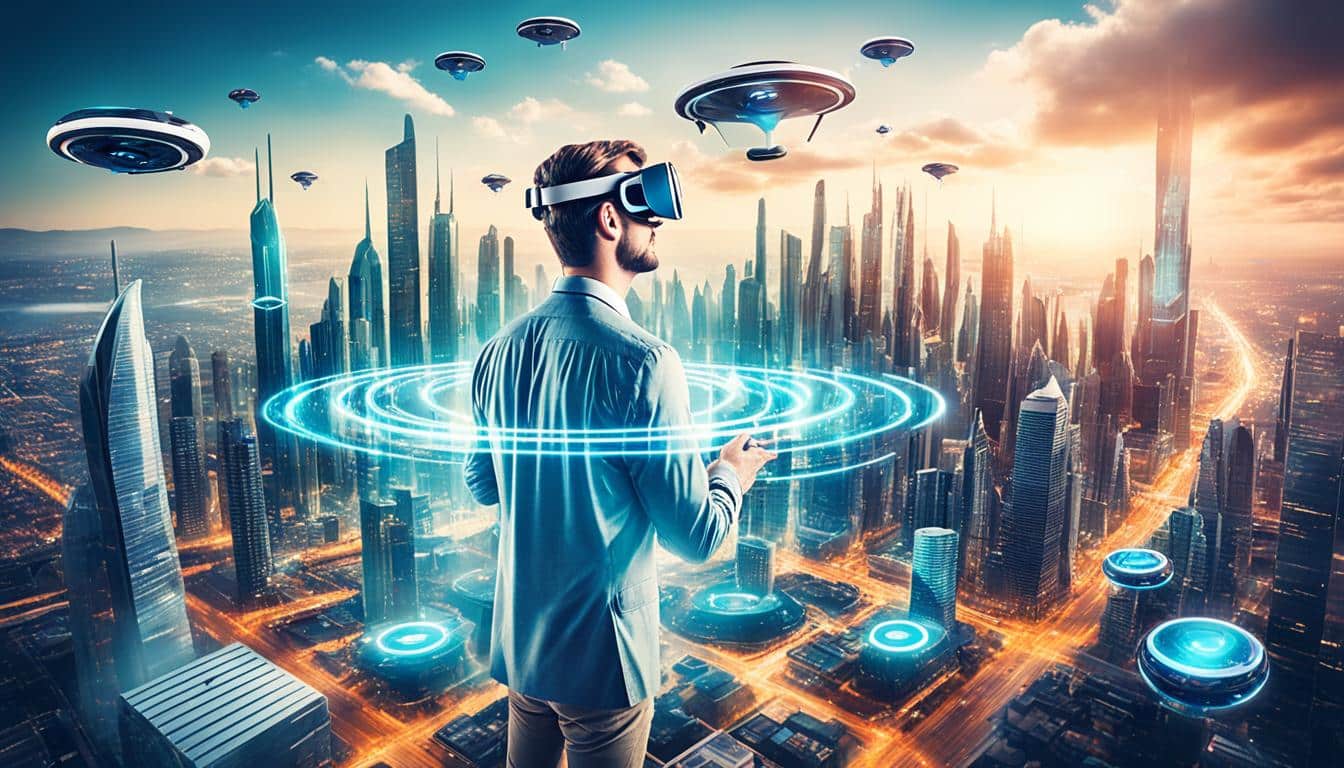Smart Technology’s Impact On Health : Smart technology and digital transformation in healthcare have ushered in a new era of patient care and health optimization. Advancements in health tech, including the Internet of Things (IoT) in healthcare and digital health tools, are revolutionizing the way healthcare is delivered and improving patient outcomes.
From smart monitors to telehealth solutions, connected emergency response systems to AI-powered smart hospitals, smart technology is reshaping the healthcare landscape. Wearable devices have proven instrumental in heart health research projects, accurately detecting abnormal rhythms. Remote monitoring and automated healthcare systems enable proactive care choices based on real-time data, while telehealth and remote care services provide convenient and accessible healthcare options.
Key Takeaways:
- Smart technology and digital transformation are revolutionizing patient care and improving outcomes.
- Examples of smart technology in healthcare include smart monitors, telehealth solutions, connected emergency response systems, and AI-powered smart hospitals.
- Wearable devices have been effective in heart health research projects, accurately detecting abnormal rhythms.
- Remote monitoring and automated healthcare systems enable proactive care choices based on real-time data.
- Telehealth and remote care services provide convenient and accessible healthcare options.
The Definition of Smart Technology in Healthcare
Smart technology in healthcare refers to devices that utilize AI, connectivity to the cloud, and other modern functionalities. These devices include smart beds that track patient movements and send alerts to nurses, inventory management systems powered by AI, and wearable biosensors that monitor vital health signs.
The benefits of wearable technology in healthcare are significant. These innovative devices provide real-time data collection, continuous monitoring, and personalized insights into an individual’s health. By leveraging the power of technology, healthcare professionals can make informed decisions and deliver better care to their patients.
One example of healthcare innovation with smart devices is the use of wearable biosensors. These small, non-invasive devices can be worn on the body and monitor various health parameters such as heart rate, blood pressure, and sleep patterns. The data collected by these sensors can be transmitted to healthcare providers in real-time, enabling early detection of health issues and timely interventions.
“Smart technology has the potential to improve wellness by providing proactive care procedures and enhancing the patient experience.”
Another example is the implementation of smart beds in healthcare facilities. These beds are equipped with sensors that can track patient movements, detect immobility, and even sense pressure ulcers. By alerting healthcare professionals to potential issues, smart beds can help prevent complications and improve patient outcomes.
With the increasing prevalence of chronic diseases and the need for remote patient monitoring, wearable technology plays a crucial role in healthcare. Patients can now track their health data and stay connected to their healthcare providers remotely.
Overall, the integration of smart technology in healthcare offers numerous benefits, including improved patient outcomes, enhanced efficiency in healthcare delivery, and a more personalized approach to wellness. As technology continues to advance, we can expect further innovation and progress in the field of healthcare, ultimately leading to a healthier and more connected world.
| Benefits of Wearable Technology in Healthcare |
|---|
| Real-time data collection |
| Continuous monitoring of health parameters |
| Early detection of health issues |
| Personalized insights for better care |
| Improved patient outcomes |
| Enhanced efficiency in healthcare delivery |
| Remote patient monitoring and connectivity |
Remote Monitoring and Automated Healthcare Systems

Remote monitoring is revolutionizing healthcare by enabling continuous monitoring of patients’ conditions and facilitating proactive care choices based on data trends. Through the use of wearable devices such as connected inhalers, smart watches, fitness trackers, ECG monitors, and blood pressure monitors, healthcare providers can track vital health factors and gain valuable insights for better care.
Connected Inhalers
Inhalers that are connected to digital platforms allow healthcare providers to monitor and track medication usage in real-time. This information helps in assessing treatment effectiveness, identifying potential issues, and adjusting medication plans accordingly.
Biosensors
Biosensors worn on the body provide vital health information, capturing data such as heart rate, oxygen levels, and temperature. These devices have played a crucial role in monitoring and detecting COVID-19 symptoms, enabling early intervention and timely medical support.
Wearable Devices
Smart watches, fitness trackers, ECG monitors, and blood pressure monitors offer continuous monitoring of health metrics, empowering individuals to take charge of their well-being. These devices provide real-time data that can be shared with healthcare professionals, facilitating proactive care choices based on accurate information.
“The integration of remote monitoring and automated healthcare systems allows for personalized care and early intervention, leading to improved health outcomes.”
The ability to remotely monitor patients and gather real-time data is transforming healthcare. It allows healthcare providers to make proactive care choices based on accurate information, resulting in timely interventions and better health outcomes. The seamless integration of remote monitoring and automated healthcare systems enables a more personalized approach, addressing individual needs and promoting overall wellness.
The Benefits of Remote Monitoring and Automated Healthcare Systems:
- Continuous monitoring of patient conditions
- Proactive care choices based on data trends
- Early detection and intervention for improved outcomes
- Enhanced patient engagement and control over health
- Improved accuracy and efficiency in healthcare delivery
- Reduction in healthcare costs and hospital readmissions
Remote monitoring and automated healthcare systems are paving the way for a more patient-centric approach to healthcare, allowing for individualized care and promoting healthier lives. By embracing the power of technology and data-driven insights, the future of healthcare holds promising possibilities for improved wellness and better patient outcomes.
Telehealth and Remote Care

Telehealth has emerged as a popular and convenient option for both healthcare providers and patients, particularly during the COVID-19 pandemic. This innovative approach to healthcare leverages teleconferencing technology to connect providers and patients virtually, offering a range of benefits that extend beyond traditional in-person visits.
The rise of telehealth services has transformed the way medical care is delivered. With virtual consultations, patients can receive timely and professional medical advice without the need to physically visit a doctor’s office or hospital. This has proven especially advantageous for individuals with limited mobility, those residing in remote areas, and patients with chronic conditions who require frequent monitoring and follow-up visits.
One of the key components enabling telehealth services is medical portal technology. These secure online healthcare portals facilitate efficient communication between patients and healthcare providers, allowing for the exchange of medical information, tracking of treatments, and access to health records. Additionally, medical portals seamlessly integrate with wearable devices, enabling the seamless transfer of vital health data.
By utilizing telehealth and medical portal technology, healthcare professionals can improve patient outcomes and increase access to care. Telemedicine not only reduces the strain on hospital resources but also helps to decrease mortality rates among ICU patients. Patients can conveniently receive essential medical advice and prescriptions through virtual consultations, promoting efficient and effective healthcare.
“Telehealth has revolutionized how we deliver healthcare, providing accessible and convenient care options for patients, regardless of their location. Medical portal technology complements telehealth services by empowering patients to actively participate in their own healthcare management, leading to improved outcomes and greater patient satisfaction.”
Benefits of Telehealth and Remote Care:
- Convenient access to medical advice and prescriptions
- Increased patient engagement and participation in healthcare
- Reduced strain on hospital resources
- Improved patient outcomes and satisfaction
- Enhanced monitoring and follow-up care
- Expanded access to specialized medical expertise
As technology continues to advance, telehealth and remote care will undoubtedly play a pivotal role in the future of healthcare. By embracing virtual care solutions, healthcare providers can deliver high-quality healthcare services to a wider population, improve patient outcomes, and ensure the accessibility and affordability of healthcare overall.
Connected Emergency Response Solutions

In emergency care, connectivity plays a crucial role in improving efficiency and response times. By facilitating real-time communication between ambulances, physicians, first responders, and emergency departments, connected solutions enable immediate access to critical information. This enables healthcare providers to make more informed and timely decisions, leading to better patient outcomes.
One significant advancement in connected emergency care is the ability to conduct video calls with doctors from inside ambulances. This feature allows paramedics and physicians to collaborate and discuss patient conditions in real-time, even before arriving at the hospital. The visual aspect of video calls can provide valuable insights and aid in triaging patients, ensuring the right level of care is provided promptly.
Another benefit of connectivity in emergency care is quick access to patient data. Upon arrival at the hospital, doctors can access vital signs and medical history, allowing for a comprehensive understanding of the patient’s condition. This real-time data access enables more accurate diagnoses and personalized treatment plans, improving overall care quality.
“Connectivity in emergency care facilitates real-time communication and quick access to patient data, leading to more informed care decisions and improved patient outcomes.”
To provide a visual representation of the impact of connected emergency response solutions, the following table outlines the benefits of connectivity in emergency care:
| Benefits of Connectivity in Emergency Care |
|---|
| Real-time communication between ambulances, physicians, and emergency departments |
| Video calls with doctors for immediate collaboration and triaging |
| Quick access to patient data, including vital signs and medical history |
Note: The table above highlights the key benefits of connectivity in emergency care, enabling improved response times and enhanced patient care.
The integration of smart technology in emergency response solutions is transforming the way healthcare providers deliver care, providing them with the tools and information they need to make critical decisions in a timely manner. By leveraging connectivity, real-time responses, video calls with doctors, and quick patient data access, the future of emergency care is becoming more efficient and effective.
Smart Hospital Management

In the era of advanced healthcare, smart hospital management is revolutionizing the way hospitals operate and deliver patient care. By leveraging cutting-edge technologies such as Internet of Things (IoT) and Artificial Intelligence (AI), hospitals can optimize resource management, enhance the patient experience, and improve operational efficiency.
One of the key benefits of smart hospital management is efficient resource utilization. With IoT sensors and AI algorithms, hospitals can monitor and manage medical equipment, supplies, and inventory in real-time. This ensures the availability of critical resources when needed, reduces waste, and streamlines workflows. For example, smart beds equipped with sensors can track patient movements and automatically alert nurses when assistance is required.
Energy management is another area where smart technology makes a significant impact. Energy management systems equipped with IoT sensors and AI algorithms can regulate energy consumption in hospitals, leading to cost-efficiency and reduced environmental footprint. These systems automatically adjust the lighting, heating, and cooling in different areas of the hospital based on occupancy and demand, optimizing energy usage without compromising patient comfort.
IoT-enabled systems also play a crucial role in improving patient flow within the hospital. Smart technologies such as real-time location systems (RTLS) can track the movement of patients, staff, and equipment, providing actionable insights to optimize workflows and minimize wait times. For example, hospitals can analyze data on patient flow patterns to identify bottlenecks and make informed decisions to improve overall efficiency and patient satisfaction.
Smart hospital management improves efficiency, enhances patient experience, and helps healthcare providers by connecting digital systems.
In conclusion, smart hospital management powered by IoT and AI is reshaping the future of healthcare. Efficient resource management, energy optimization, and enhanced patient flow are key attributes of smart hospitals. By embracing these technologies, hospitals can ensure better patient care, streamline operations, and deliver healthcare services with utmost precision and effectiveness.
Smart Hospital Management Benefits:
| Benefits | Description |
|---|---|
| Efficient resource utilization | IoT and AI optimize resource management, reducing waste and ensuring availability of critical resources. |
| Energy management | Smart energy management systems regulate energy consumption for cost-efficiency and reduced environmental impact. |
| Patient flow optimization | IoT-enabled systems track movements and minimize wait times, enhancing overall patient flow within the hospital. |
The Positive Impacts of Smart Devices on Health

Smart devices have revolutionized healthcare by leveraging IoT and AI technologies to enhance the health outcomes for individuals, including older adults. These innovative devices enable remote patient monitoring, chronic disease management, and proactive interventions, leading to improved overall health.
One significant benefit of smart devices is their ability to facilitate remote patient monitoring. Through IoT connectivity, healthcare providers can remotely track vital health signs, such as heart rate, blood pressure, and glucose levels. This real-time data allows for early detection of health issues, enabling timely interventions and preventing complications. For example, smart wearable devices equipped with biosensors can continuously monitor heart rhythm abnormalities, enhancing cardiovascular disease management and reducing the risk of adverse events.
Another area where smart devices shine is in improving patient-physician interactions through telehealth solutions. Telehealth enables virtual consultations between patients and healthcare providers, reducing the need for physical hospital visits. This technology not only improves access to care, especially for individuals in remote or underserved areas, but also reduces the spread of infectious diseases, as observed during the COVID-19 pandemic. With telehealth, patients can receive timely medical advice, prescriptions, and follow-up care, ensuring continuity and convenience.
MHealth applications also play a crucial role in empowering patients to actively participate in their well-being. These mobile apps provide personalized and interactive platforms for individuals to monitor their fitness, track medication adherence, and access reliable health information. By actively engaging with their health, patients can make informed decisions, adopt healthier lifestyles, and effectively manage chronic conditions. MHealth apps also promote preventive care by offering tailored recommendations based on individual health data, further improving health outcomes.
“Smart devices have revolutionized healthcare by leveraging IoT and AI technologies to enhance the health outcomes for individuals.”
In addition to remote monitoring and patient empowerment, smart devices contribute to personalized healthcare through personalized fitness tracking. Wearable devices, such as smartwatches and fitness trackers, collect data on steps, heart rate, and sleep quality, providing individuals with insights into their physical activity and overall well-being. This information enables users to set personalized goals, track progress, and make lifestyle changes for improved health.
Furthermore, smart devices offer seamless access to health information, ensuring individuals have the necessary resources to make informed decisions about their health. From medication management apps to digital health portals, these devices facilitate easy and secure access to personal health records, lab results, and educational materials. This accessibility promotes health literacy and enables individuals to take an active role in managing their own health and well-being.
| Benefits of Smart Devices on Health | Keywords |
|---|---|
| Remote patient monitoring | IoT, chronic disease management |
| Enhanced patient-physician interactions | Telehealth, virtual consultations |
| Empowerment through MHealth applications | Personalized healthcare, health information access |
| Personalized fitness tracking | Fitness trackers, smartwatches |
Overall, smart devices have a positive impact on health outcomes by enabling remote monitoring, promoting patient empowerment, and delivering personalized healthcare. Through IoT, AI, MHealth, and telehealth, these devices revolutionize care delivery and contribute to proactive interventions, improved patient experiences, and better overall health. As technology continues to advance, smart devices will play an increasingly vital role in healthcare, driving enhanced wellness and a healthier future.
Negative Impacts of Technology on Health

While smart technology has revolutionized healthcare and improved patient outcomes, excessive use of technology can have negative effects on our health. Here are some of the common negative impacts:
- Musculoskeletal Issues: Prolonged screen time can lead to neck and back pain, affecting our posture and causing discomfort.
- Digital Eye Strain: Staring at screens for extended periods can result in digital eye strain, causing dry eyes, headaches, and blurred vision.
- Disrupted Sleep: Using smartphones and tablets before bed can disrupt sleep patterns and affect the circadian rhythm, making it harder to fall asleep and wake up refreshed.
- Physical Inactivity: Excessive screen time often leads to sedentary behaviors, reducing physical activity levels and increasing the risk of health conditions like obesity and heart disease.
- Psychological Issues: Overuse of technology can negatively impact mental and emotional well-being, leading to increased anxiety, stress, and depression.
- Hearing Loss: Prolonged use of earphones at high volumes can cause hearing loss and damage to our auditory system.
- Effects on Kids: Children and teenagers are particularly vulnerable to the negative effects of technology, as excessive screen time can hinder social skills development, attention spans, and physical health.
To maintain a healthy balance, it is essential to practice moderation and prioritize our well-being. Taking regular breaks from screens, engaging in physical activity, and promoting digital wellness can help mitigate these negative impacts.
Excessive screen time can lead to various health issues, from musculoskeletal problems to psychological distress. It is important to be mindful of our technology use and find a healthy balance in this digital age.
Smart Device Use and Older Adults’ Health Status
The use of smart devices has shown significant positive effects on the self-rated, physical, and psychological health of older adults. Research indicates that older adults who incorporate smart devices into their daily lives experience improved overall health outcomes and well-being.
One study found that older adults living in urban areas or those in higher age groups benefitted the most from smart device use in terms of health improvements. This suggests that the impact of smart devices on health is influenced by individual characteristics and environmental factors.
Smart devices play a crucial role in improving self-rated health among older adults. By using smart devices to monitor vitals, track fitness levels, and manage medications, older adults gain better control over their health. With easy access to health-related information and resources, they are empowered to make informed decisions and adopt healthier lifestyle choices.
Furthermore, the use of smart devices positively influences psychological health in older adults. By promoting social connectivity, cognitive stimulation, and entertainment options, smart devices can alleviate feelings of isolation and loneliness often experienced by older adults. Engaging with technology can provide opportunities for learning, creativity, and mental engagement.
Encouraging the understanding and practicality of smart devices among older adults is crucial for leveraging the benefits of these devices. Providing education, training, and support tailored to the specific needs and preferences of older adults can enhance their adoption and use of smart devices for health-related purposes.
To sum up, smart device use has the potential to improve the self-rated, physical, and psychological health of older adults. By embracing these technologies and promoting digital literacy, we can effectively enhance the health status of older adults and ensure their well-being in the digital era.
Implications for Improving Digital Literacy and Health

Improving digital literacy among older adults is crucial to ensure they can fully benefit from smart technology and digital healthcare. Health literacy programs, including education on internet health information, can significantly enhance older adults’ understanding of their health and improve their overall health outcomes.
By prioritizing the needs and practicality for older adults in the development of smart devices, we can promote healthy aging and accurate geriatric health support strategies. Wide application of smart devices in older adult care can bridge the digital divide and support their health and well-being.
eHealth platforms and initiatives that provide user-friendly interfaces and personalized guidance contribute to improving digital literacy and health outcomes for older adults. By empowering older adults with the knowledge and skills to effectively use smart devices and access digital healthcare resources, we enable them to actively participate in their own care and foster a sense of control and autonomy.
Benefits of Improving Digital and Health Literacy for Older Adults
1. Enhanced access to healthcare information and resources.
2. Improved self-management of chronic conditions.
3. Increased engagement in preventive care and health promotion.
4. Facilitated communication with healthcare providers and access to telehealth services.
5. Reduced healthcare disparities and improved health equity.
“Improving digital literacy among older adults is essential in empowering them to navigate smart technology and digital healthcare resources effectively.” – Dr. Samantha Johnson, Geriatric Medicine Specialist
To further illustrate the implications of improving digital literacy and health, below is a table showcasing the benefits of smart device development for healthy aging:
| Benefits of Smart Device Development for Healthy Aging |
|---|
| Promotes active lifestyles through fitness tracking and reminders for physical activity. |
| Facilitates medication management and adherence through reminders and tracking. |
| Provides access to personalized health information and resources. |
| Enables remote monitoring and communication with healthcare providers. |
| Promotes cognitive health through brain training exercises and mental stimulation. |
By improving digital literacy and health literacy among older adults and promoting the development of smart devices tailored to their needs, we can create a more inclusive and empowered healthcare ecosystem.
Challenges and Future Considerations

The adoption of smart technology in healthcare brings forth a unique set of challenges that require careful consideration. These challenges include ethical considerations, privacy concerns, cybersecurity risks, and the need for digital inclusion.
Ethical considerations arise from the potential misuse or unintended consequences of smart technology in healthcare. It is essential to ensure that these technologies adhere to ethical standards and prioritize patient well-being.
Privacy concerns are paramount when implementing smart technology. Safeguarding patient data and maintaining confidentiality are crucial to establish trust and ensure compliance with privacy regulations.
“Protecting patient data and ensuring secure communication channels are crucial for the successful implementation of smart technology.”
Another crucial consideration is cybersecurity. As smart technology becomes more prevalent in healthcare, the risk of cyber threats increases. Robust cybersecurity measures must be implemented to safeguard against data breaches and protect both patient information and the integrity of the healthcare system.
Digital inclusion is a pressing concern in the adoption of smart technology. It is essential to bridge the gap between those who have access to smart technology and those who do not. Ensuring equal opportunities for healthcare access and utilization is crucial to prevent exacerbating existing health disparities.
Ongoing research and advancements in smart technology will continue to shape the future of healthcare. By addressing these challenges, the healthcare industry can unlock the full potential of smart technology and leverage its benefits to improve patient care delivery.
In conclusion, while the adoption of smart technology in healthcare presents challenges, such as ethical considerations, privacy concerns, cybersecurity risks, and the need for digital inclusion, addressing these challenges will pave the way for a future where smart technology improves patient care, enhances health outcomes, and creates a more accessible and equitable healthcare system.
Conclusion
Smart technology’s impact on health is transforming the healthcare landscape and revolutionizing patient care. The adoption of smart devices, telehealth, and digital healthcare tools has the potential to create a healthier world by improving proactive care procedures and enhancing the overall patient experience.
Smart technology enables remote monitoring, real-time communication, and data-driven insights, empowering healthcare providers to deliver personalized and efficient care. Telehealth services have become increasingly popular, providing convenient access to medical advice and reducing physical hospital visits. Digital healthcare tools, such as wearables and biosensors, allow for continuous monitoring and early detection of health conditions.
While challenges and concerns exist, such as ethical considerations, privacy issues, and cybersecurity risks, ongoing advancements and research in smart technology will continue to shape the future of healthcare. By addressing these challenges and leveraging the potential of smart technology, we can improve the delivery of patient care, optimize health outcomes, and pave the way for a more efficient and effective healthcare system.
The future of healthcare lies in embracing digital innovation and integrating smart technology into every aspect of patient care. With continued advancements, digital healthcare has the potential to transform the way we manage and prioritize our health, ultimately leading to a healthier and more connected society.
Also Refer : 10 Must-Know Tech Trends For Businesses And Consumers
FAQs
Q: What is the impact of smart technology on healthcare?
A: Smart technology has revolutionized healthcare by improving efficiency, enhancing patient care, and enabling better communication among medical staff and patients.
Q: How is smart technology transforming the healthcare system?
A: Smart technology is transforming the healthcare system by integrating information technology, digital technologies, and communication technology to create a smart health ecosystem that benefits both healthcare providers and patients.
Q: What are some positive impacts of technology in the healthcare sector?
A: Technology can also improve patient health outcomes, enhance healthcare efficiency, and enable healthcare organizations to provide patient-centric care using smart health solutions.
Q: How are smart devices and health monitoring contributing to smart health?
A: Smart devices and health monitoring tools enable real-time tracking of patient health data, leading to better healthcare outcomes and more personalized care in the healthcare environment.
Q: How can technology improve the efficiency of healthcare organizations?
A: By integrating digital technologies and smart health solutions, healthcare organizations can streamline processes, reduce administrative burdens, and enhance overall efficiency in delivering healthcare services.
Q: What role does intelligence play in transforming the healthcare sector?
A: Intelligence in healthcare, through the use of data analytics and smart technologies, plays a crucial role in improving decision-making processes, optimizing healthcare delivery, and maximizing the potential health benefits for patients.
Q: How are global healthcare organizations leveraging smart technology?
A: Global healthcare organizations, including the World Health Organization and national institutes of health medical devices, are incorporating smart technology such as smart glasses and electronic health records to provide smarter, more efficient healthcare services on a global scale.













